
Bordeaux is a port city on the river Garonne in the Gironde department, Southwestern France. It is the capital of the Nouvelle-Aquitaine region, as well as the prefecture of the Gironde department. Its inhabitants are called "Bordelais" (masculine) or "Bordelaises" (feminine). The term "Bordelais" may also refer to the city and its surrounding region.
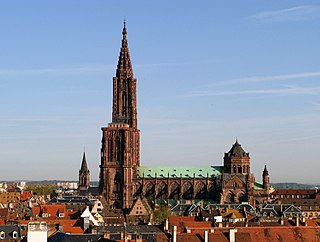
Strasbourg is the prefecture and largest city of the Grand Est region of eastern France and the official seat of the European Parliament. Located at the border with Germany in the historic region of Alsace, it is the prefecture of the Bas-Rhin department.

Toulouse is the prefecture of the French department of Haute-Garonne and of the larger region of Occitania. The city is on the banks of the River Garonne, 150 kilometres from the Mediterranean Sea, 230 km (143 mi) from the Atlantic Ocean and 680 km (420 mi) from Paris. It is the fourth-largest city in France after Paris, Marseille and Lyon, with 498,003 inhabitants within its municipal boundaries ; its metropolitan area has a population of 1,470,899 inhabitants. Toulouse is the central city of one of the 22 metropolitan councils of France. Between the 2014 and 2020 censuses, its metropolitan area was the third fastest growing among metropolitan areas larger than 500,000 inhabitants in France.

A crescent shape is a symbol or emblem used to represent the lunar phase in the first quarter, or by extension a symbol representing the Moon itself.
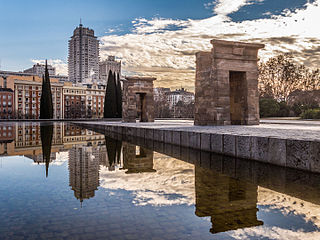
A reflecting pool, also called a reflection pool, is a water feature found in gardens, parks, and memorial sites. It usually consists of a shallow pool of water, undisturbed by fountain jets, for a reflective surface.

The Royal Palace of Caserta is a former royal residence in Caserta, southern Italy, constructed by the House of Bourbon-Two Sicilies as their main residence as kings of Naples. It is the largest palace erected in Europe during the 18th century. In 1997, the palace was designated a UNESCO World Heritage Site; its nomination described it as "the swan song of the spectacular art of the Baroque, from which it adopted all the features needed to create the illusions of multidirectional space". The Royal Palace of Caserta is the largest former royal residence in the world, over 2 million m3 in volume and covering an area of 47,000 m2.

Ange-Jacques Gabriel was the principal architect of King Louis XV of France. His major works included the Place de la Concorde, the École Militaire, and the Petit Trianon and opera theater at the Palace of Versailles. His style was a careful balance between French Baroque architecture and French neoclassicism.
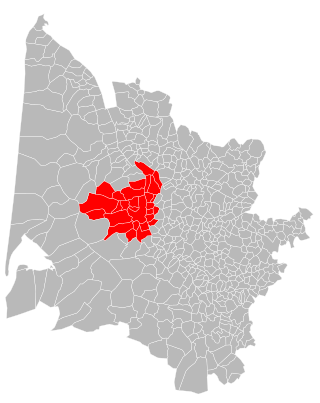
Bordeaux Métropole is the métropole, an intercommunal structure, centred on the city of Bordeaux. It is located in the center of the Gironde department, in the Nouvelle-Aquitaine region, in South West France. It represents about half of the department's population. It was created in January 2015, replacing the previous Communauté urbaine de Bordeaux. It brings together 28 municipalities, and covers an area of 578.3 km2 (223.3 sq mi). Its population was 801,041 in 2018, of which 257,068 resided in Bordeaux proper.

Sagua la Grande is a municipality located on the north coast of the province of Villa Clara in central Cuba, on the Sagua la Grande River. The city is close to Mogotes de Jumagua, limestone cliffs. Many cays of the Sabana-Camaguey Archipelago are located off the northern coast. People born in Sagua are called "guajiros".

The Franciscan missions of the Sierra Gorda of Querétaro in Mexico, are five missions built between 1750 and 1760, the foundation of the missions is attributed to Junípero Serra, who also founded the most important missions in California. They were declared a World Heritage Site by UNESCO in 2003.

The Place des Quinconces, located in Bordeaux, France, is among the largest city squares in Europe.
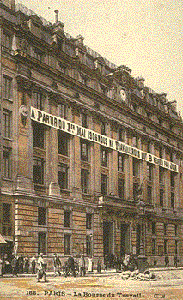
The Bourse du Travail, a French form of the labour council, were working class organizations that encouraged mutual aid, education, and self-organization amongst their members in the late nineteenth and early twentieth centuries.
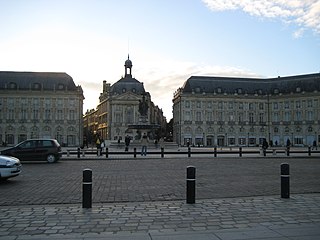
Place de la Bourse is a station located on line of the tramway de Bordeaux in France.

The Bassin de la Villette is the largest artificial lake in Paris. It was filled with water on 2 December 1808. Located in the 19th arrondissement of the capital, it links the Canal de l'Ourcq to the Canal Saint-Martin, and it represents one of the elements of the Réseau des Canaux Parisiens, a public-works authority operated by the city. The other components of the network are the Canal de l'Ourcq, the Canal Saint-Denis, the Canal Saint-Martin, and the Bassin de l'Arsenal. Together, these canals and basins extend roughly 130 kilometres (81 mi).

Nicolas Michelin is a French architect and urban planner. After joining forces with Finn Geipel to form LABFAC in 1985, he went on to found ANMA in 2000, which he currently runs in collaboration with his partners Michel Delplace and Cyril Trétout.

Place de la Bourse is a square in Bordeaux, France and one of the city's most recognisable sights. Built from 1730 to 1775 along the river Garonne, it was a multi-building development designed by architect Ange-Jacques Gabriel. It is within the historic part of the city that has been recognized on the UNESCO World Heritage List as "an outstanding urban and architectural ensemble" of the 18th century.

The Miroir d'eau in Bordeaux is the world's largest reflecting pool, covering 3,450 square metres (37,100 sq ft). Located on the quay of the Garonne in front of the Place de la Bourse, it was built in 2006.
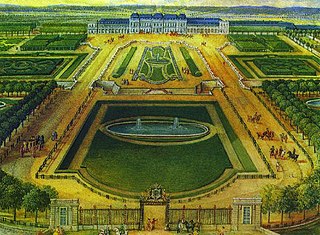
The Château de Chanteloup was an imposing 18th-century French château with elaborate gardens, compared by some contemporaries to Versailles. It was located in the Loire Valley on the south bank of the river Loire, downstream from the town of Amboise and about 2.3 kilometres (1.4 mi) southwest of the royal Château d'Amboise. From 1761 to 1785 Chanteloup belonged to King Louis XV's prime minister, the Duke of Choiseul. The château was mostly demolished in 1823, but some features of the park remain, notably the Pagoda of Chanteloup, a significant tourist attraction.

The Tribunal de commerce de Paris, until 1968 Tribunal de commerce de la Seine, refers both to the tribunal de commerce of Paris, a commercial court, and to the building that hosts it on the Île de la Cité in Paris. Because that building's main entrance is on the quai de la Corse, the phrase Quai de la Corse is used as a nickname for the court, not least with reference to its role in corporate insolvencies.





























